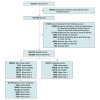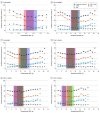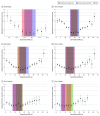Association of Optimal Gestational Weight Gain Ranges With Perinatal Outcomes Across Body Mass Index Categories in Twin Pregnancies
- PMID: 35852802
- PMCID: PMC9297120
- DOI: 10.1001/jamanetworkopen.2022.22537
Association of Optimal Gestational Weight Gain Ranges With Perinatal Outcomes Across Body Mass Index Categories in Twin Pregnancies
Abstract
Importance: The existing gestational weight gain (GWG) recommendations for twin pregnancies are lacking for underweight individuals and are not stratified by obesity class.
Objective: To identify optimal GWG ranges associated with reduced adverse perinatal outcomes stratified by prepregnancy body mass index (BMI) categories in twin pregnancies.
Design, setting and participants: This population-based cohort study of twin pregnancies using data from the National Center for Health Statistics was conducted between January 1, 2014, and December 31, 2018. Statistical analysis was performed from October 24, 2021, to May 7, 2022. The study population comprised 262 604 individuals between 18 and 45 years of age with live-born twins without congenital malformation between 24 and 42 weeks of gestation. Two approaches were used to determine the optimal GWG ranges: a statistics-based approach calculating IQRs of GWG in a low-risk population, and an outcome-based approach identifying GWG thresholds below or above which an adverse perinatal outcome increased.
Exposure: Gestational weight gain.
Main outcomes and measures: Preterm birth less than 36 weeks, gestational hypertensive disorders, small for gestational age status, large for gestational age status, and a composite outcome defined as any occurrence of the individual outcomes.
Results: The main sample comprised 200 810 individuals with twin pregnancies (mean [SD] maternal age, 30.4 [5.5] years; 1624 [0.8%] American Indian or Alaska Native, 13 031 [6.5%] Asian or Pacific Islander, 36 423 [18.1%] Black, and 149 732 [74.6%] White; and 137 409 [68.4%] multiparous). In the low-risk subgroup (n = 61 794), the IQRs of the total GWG after 36 weeks of gestation as assessed using a statistics-based approach and based on BMI group were 15.9 to 22.7 kg for underweight, 15.4 to 22.7 kg for normal weight, 12.7 to 22.2 kg for overweight, 10.0 to 20.0 kg for class 1 obesity, 7.7 to 18.1 kg for class 2 obesity, and 5.9 to 16.3 kg for class 3 obesity. The absolute risk of the composite outcome showed U-shaped associations with GWG across BMI categories. The optimal GWG ranges by 36 weeks identified using an outcome-based approach and BMI group were 17.5 to 24.9 kg for underweight, 15.0 to 24.9 kg for normal weight, 15.0 to 24.9 kg for overweight, 10.0 to 19.9 kg for class 1 obesity, 7.5 to 17.4 kg for class 2 obesity, and 5.0 to 9.9 kg for class 3 obesity. The multivariable logistic models assessed using the validation sample (n = 49 275) showed that GWG defined outside those optimal ranges was associated with preterm birth at less than 36 weeks, gestational hypertensive disorders, and small or large for gestational age.
Conclusions and relevance: This population-based cohort study found that optimal GWG ranges were similar for individuals with underweight and normal weight but decreased with increasing severity of obesity. The current US Institute of Medicine GWG recommendations may be too high for individuals with moderate or severe obesity.
Conflict of interest statement
Figures




Comment in
-
Establishing Optimal Gestational Weight Gain in Twin Pregnancies With a Prerequisite Rationale-A Tour de Force.JAMA Netw Open. 2022 Jul 1;5(7):e2222546. doi: 10.1001/jamanetworkopen.2022.22546. JAMA Netw Open. 2022. PMID: 35852806 No abstract available.
Similar articles
-
Investigation of optimal gestational weight gain for twin pregnancy in Southwest China: a retrospective study.Sci Rep. 2023 Mar 28;13(1):5059. doi: 10.1038/s41598-023-31766-7. Sci Rep. 2023. PMID: 36977708 Free PMC article.
-
The gestational weight gain and perinatal outcomes among underweight women with twin pregnancies: Propensity score matched analysis from a three-year retrospective cohort.Eur J Obstet Gynecol Reprod Biol. 2019 Dec;243:97-102. doi: 10.1016/j.ejogrb.2019.10.009. Epub 2019 Oct 21. Eur J Obstet Gynecol Reprod Biol. 2019. PMID: 31678762
-
Maternal weight gain and pregnancy outcomes in twin gestations.Am J Obstet Gynecol. 2021 Nov;225(5):532.e1-532.e12. doi: 10.1016/j.ajog.2021.04.260. Epub 2021 May 10. Am J Obstet Gynecol. 2021. PMID: 33984302
-
Association between gestational weight gain and perinatal outcomes among twin gestations based on the 2009 Institute of Medicine (IOM) guidelines: a systematic review.J Matern Fetal Neonatal Med. 2022 Dec;35(25):6527-6541. doi: 10.1080/14767058.2021.1918083. Epub 2021 May 27. J Matern Fetal Neonatal Med. 2022. PMID: 34044741
-
[Maternal and neonatal outcomes according to gestational weight gain in twin pregnancies: Are the IOM guidelines associated with better issues?].Gynecol Obstet Fertil Senol. 2017 Jun;45(6):366-372. doi: 10.1016/j.gofs.2017.02.003. Epub 2017 Mar 31. Gynecol Obstet Fertil Senol. 2017. PMID: 28366706 Review. French.
Cited by
-
Effect of gestational weight gain on adverse birth outcomes in twin pregnancies: a prospective cohort study in Chinese women.BMC Pregnancy Childbirth. 2025 Feb 17;25(1):169. doi: 10.1186/s12884-025-07234-7. BMC Pregnancy Childbirth. 2025. PMID: 39962413 Free PMC article.
-
Impact of Gestational Diabetes and Hypertension Disorders of Pregnancy on Neonatal Outcomes in Twin Pregnancies Based on Chorionicity.J Clin Med. 2023 Jan 31;12(3):1096. doi: 10.3390/jcm12031096. J Clin Med. 2023. PMID: 36769744 Free PMC article.
-
Gestational weight gain adequacy among twin pregnancies in France.Matern Child Nutr. 2023 Jan;19(1):e13436. doi: 10.1111/mcn.13436. Epub 2022 Oct 12. Matern Child Nutr. 2023. PMID: 36222213 Free PMC article.
-
The Impact of Gestational Diabetes Mellitus on the Development of Preeclampsia in Twin Pregnancies: A Retrospective Cohort Study Conducted at a Tertiary Hospital.Int J Womens Health. 2025 Jan 20;17:75-86. doi: 10.2147/IJWH.S500531. eCollection 2025. Int J Womens Health. 2025. PMID: 39866822 Free PMC article.
-
Optimal Gestational Weight Gain for Women with Gestational Diabetes Mellitus - China, 2011-2021.China CDC Wkly. 2023 Mar 3;5(9):189-193. doi: 10.46234/ccdcw2023.034. China CDC Wkly. 2023. PMID: 37007862 Free PMC article.
References
-
- Madar H, Goffinet F, Seco A, Rozenberg P, Dupont C, Deneux-Tharaux C; EPIMOMS (EPIdémiologie de la MOrbidité Maternelle Sévère) Study Group . Severe acute maternal morbidity in twin compared with singleton pregnancies. Obstet Gynecol. 2019;133(6):1141-1150. doi:10.1097/AOG.0000000000003261 - DOI - PubMed
MeSH terms
LinkOut - more resources
Full Text Sources
Medical

